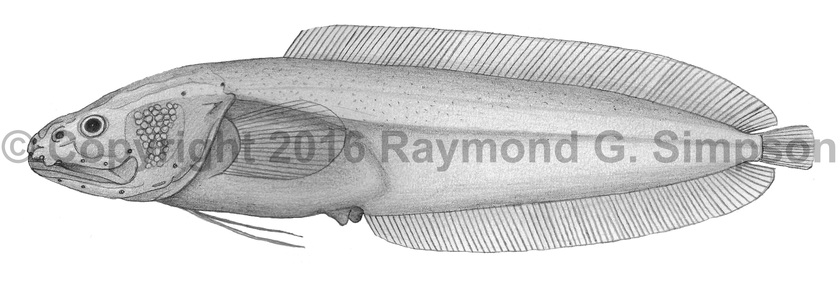
Common Name
Key Coralbrotula
Year Described
Evermann & Kendall, 1898
Identification
Dorsal Fin: 66-76
Anal Fin: 50-57
Caudal Fin: 14-17
Pectoral Fin: 16-21
Vertebrae: 39-41
Gill Rakers: 12-17
Diagnosed by: anterior nostril very close to upper lip. Eye is 2.0-3.2% SL. Premaxillary, dentary, vomer, and palatine with multiple rows of teeth each. Male genitalia described as: “outer and inner pseudoclaspers simple, triangular flaps, outer about 2 times size of inner pseudoclasper; penis tapering…” Opercular spine with a single point. Scales on cheek number 4-6. Six infraorbital pores, four supraorbital pores, six mandibular pores, and four preopercular pores. Caudal fin not confluent with dorsal or anal fins. Pectoral fin 10.4-15.4% SL. Anal fin origin at midbody. Pelvic fin does not reach anus. Predorsal area, abdomen, and outer pectoral base scaled. Fins naked. About 15 scale rows vertically from dorsal fin to anal fin origin (Møller et al., 2005).
Color
Body pale yellow with faint brownish speckling. Peritoneum, vertebral column, and opercular flap with pink to purplish hue. Fins transparent.
Size
Specimens range from 15-60mm SL
Habitat
Found mostly in shallow water from 0-8m, but the NC record was taken at over 30m depth.
Range
Scattered records off of North Carolina, S. Florida, N. Cuba, and Bermuda.
References
Møller, P. R., Schwarzhans, W., & Nielsen, J. G. 2005. Review of the American Dinematichthyini (Teleostei: Bythitidae). Part II. Ogilbia. aqua, Journal of Ichthyology and Aquatic Biology, 10(4), 133-207.
Other Notes
Most of the more recently described Ogilbia sp. from the Caribbean were lumped under this name for many years. The species as described in Møller et al. (2005) is restricted to the Northern Caribbean and the southeastern U.S.